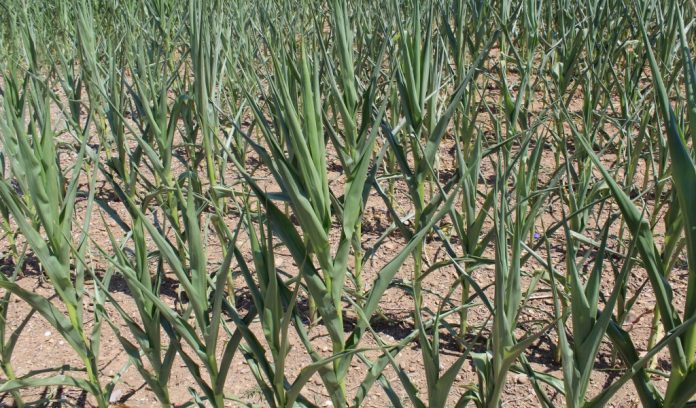Not much doubt what the two hot topics are today where grain farmers gather. One is how dry everything is and the other is, “How can prices be so low?”
I was talking to a friend yesterday who farms in Northeast Ohio. He wanted to talk about both topics. I has not rained at his farm for 15 days, and that is rare in that area. The forecast shows no rain until maybe next Sunday, with a 48% chance.
He says the crops were planted in good conditions and still look good, but in another week they will be getting very thirsty.
I am also told that those brave folks who planted corn in the first 10 days of April have mostly gotten away with it. The corn came up the same time as the corn planted later, but it did come up.
Ohio soil
The sad thing is, much of that part of Ohio does not have soils with good water-holding capacity. The topsoil is not as loamy as the best soils in the country, nor as deep. The tendency is for just eight or 10 inches of topsoil, then heavy clay.
Those along the creek bottom who have some sandy soil are already seeing the corn curl up. Those with the clay loam can expect to soon.
The favored few this year are the ones who do not do much tillage. Some of them are seeing deeper topsoil as the years go by, a matter which I was taught in college does not really happen. They have also not wasted moisture with tillage.
Lack of rain is scary, but the truth is something Pappy always preached: in our part of the world, the dry years scare you to death, but the wet years starve you to death!
In the main Corn Belt, which gets less rain normally than Ohio does, the drought area increased last week from 26% of the corn production area to 34%. Areas such as southern Minnesota which had been too wet with rain and late-melting snow has now got planted, but has turned dry.
The dry weather is reflected in last week’s first Crop Condition report from the U.S. Department of Agriculture. It shows 69% of the crop rated good and excellent, which is less than expected. The trade assumed we would come in at 71%, which is the average.
Wheat extremes
For comparison, last year we started out at 73% good and excellent. Our wheat, which God made to grow in dryer areas, is loving the current weather. It is headed out and farmers are expecting an early harvest.
We have missed the wet weather during pollination that contributes to disease problems in so many years. I am told farmers are not putting on fungicides this year because of the dry weather. It will be interesting to see how the yields are, as wheat came out of winter in great shape in the East and has thrived since.
That is not true in the Great Plains where most of our wheat is grown. They are working on dry weather, too, but so dry that they planted in three inches of dust and have actually had dust storms in Kansas this spring.
The good crop of SRW in the East does not make up for the bad crop of HRW out west, however. The two classes of wheat are very different and cannot be substituted for each other.
Poor prices
That gets us to the second big topic, the one of price. We saw some terrible prices for corn and soybeans last week. July corn touched $5.77 1/2 May 31. A couple of months ago, we still hoped to break $7!
We recovered from the lows later in the week with a nickel gain for the week, and a close of $6.05. However, we had a bad June 5, with July futures off 11 1/2 cents after a high early in the day of $6.14. That means we had a 19-cent range for the day.
In the evening session, we were up over five cents, at $6.03 The December new crop prices were similar in action, but significantly lower. December futures gained $6 3/4 cents for the week, closing at $5.41 1/4.
Trading had left us down 6 1/2 cents, but we had picked up 6-1/2 the evening of June 5 as this was being written. December was at $5.43 1/2.
The rebound in corn came partly because of surprisingly good corn exports. The trade was looking for a wide range of 600,000 bus. to 1,400,000 bus. They got over a million and a third, but we still lag the year’s USDA estimates by 109 million bushels. This is the biggest thing hanging over the market.
We continue the fear that the carryout estimate for Aug. 31 of 2023 is lower than reality. In a continuation of the talk last week, we are now well past the Prevent Plant date for the Dakotas, without getting in the extra corn acres expected there.
I have not seen numbers, but last week I was told that we would never see the 800,000 extra acres this year. I assumed this would change the acres to soybeans, but apparently, significant acres had fertilizer already applied for corn, so the farmers will go with something else, like sunflowers.
Still in the mix is the record Brazilian soybean crop that will more than make up for the drought-halved Argentine crop. The soybean prices traded in a large range. July futures put in a low May 30 at $12.94 1/4.
We did not stay under the $13 for long, though. The evening of June 5, we were trading at $13.57 3/4. Last week, the November futures were off almost 6 cents, but we most recently were three cents higher, at $11.86 1/2.
Chicago soft red wheat July futures actually gained three cents last week to $6.19. A good June 5 session had them at $6.31 1/2.












